Tomatoes are one of the stand-out vegetables growing in my garden. Knowing how to prune them properly for the greatest yield is important. My supply of homemade salsa, sauces and diced tomatoes will depend on it. You can learn how to prune tomato plants that are determinate and indeterminate with this easy tutorial giving you the best fruitful harvest.
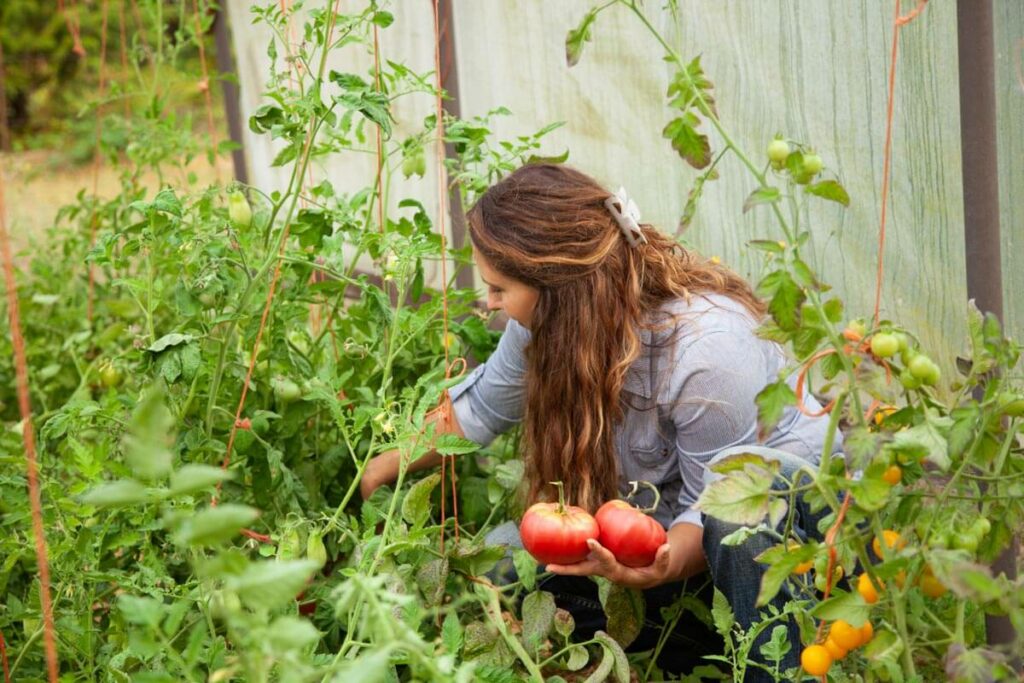
Securing a Big Harvest
I confess that tomatoes have long been my nemesis crop. The rainy summers of the Pacific Northwest can prove challenging for planting tomatoes, and then there is always treating tomato blight and the dreaded blossom drop.
If I’m being totally honest with you guys, it felt like a black mark on my homesteader’s badge.
I consider myself a fairly decent gardener, and this, my friends, was a recipe for getting it right if it kills me. While that kind of made me crazy at times, it was a huge win for you. Because you get to skip what not to do and go straight to growing a year’s worth of tomatoes with ease!
There is great satisfaction in going from pulling my hair out to admiring home-canned tomato sauce put up in my pantry and even storing green tomatoes for fresh eating months after the harvest. Plus, if you’ve never tried homemade tomato soup from your canned tomatoes, you, my friend, are missing out!
No more will you find me hucking rotten tomatoes across the fence for the livestock to nose through. Join me on the other side and learn how pruning tomatoes can greatly impact your harvest to produce fruit with the best overall yield.
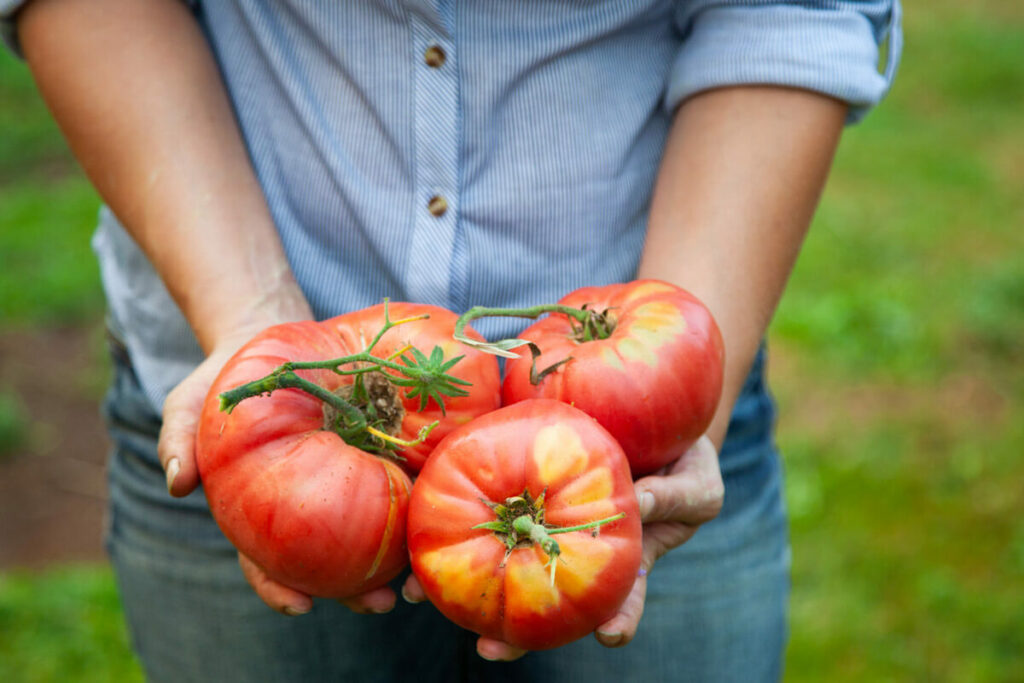
Benefits of Pruning Tomato Plants
Pruning your tomato plants will increase your harvest, and I am all about an abundant harvest. When you prune tomato plants, it keeps the energy focused on producing the fruit (and larger fruit at that). Otherwise the energy goes to the foliage and takes away from the final harvest.
Pruning your tomatoes allows better air circulation and sun penetration, which benefits the plant and reduces the chance of diseases. I know all about blight living in the cool, wet environment of the Pacific Northwest. My fifteen-plus tips for planting tomatoes will give you more insight and success if you’re struggling.
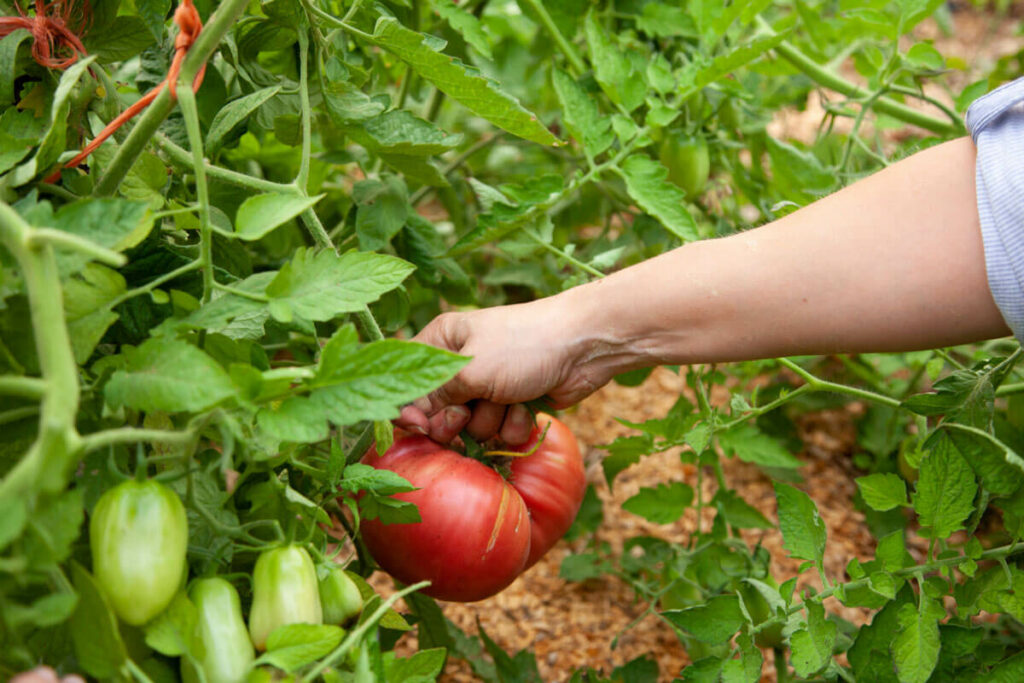
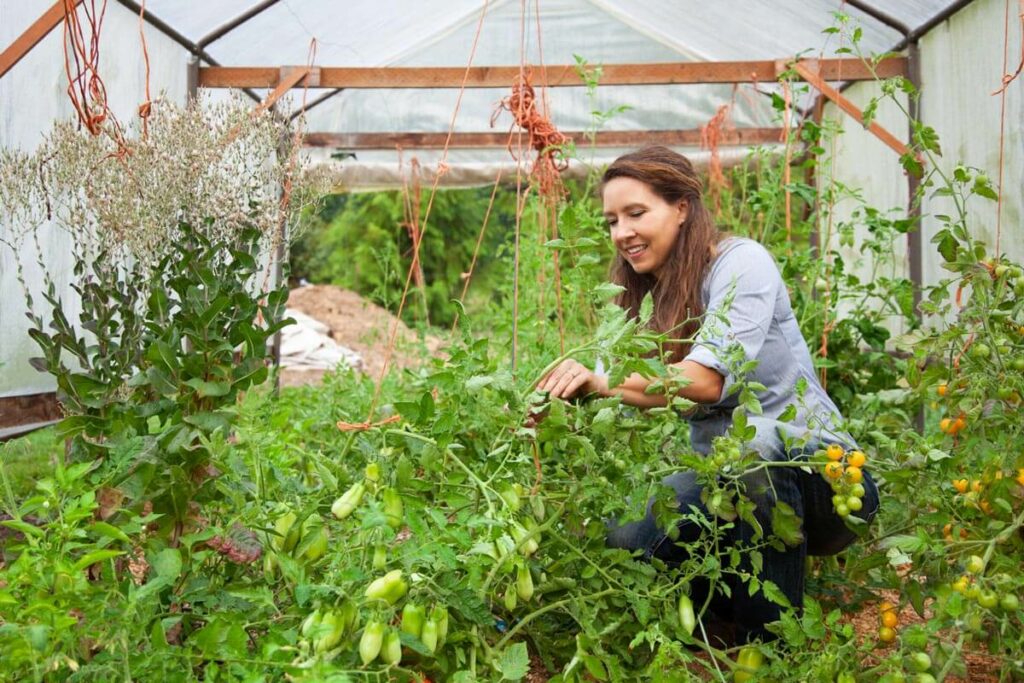
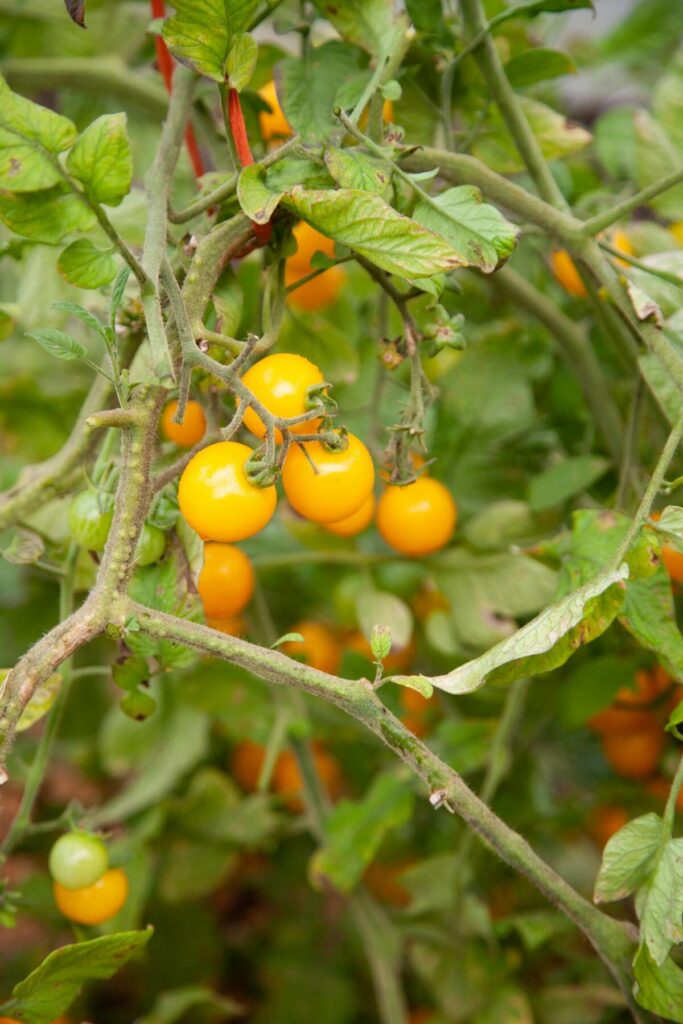
Determinate vs. Indeterminate Tomatoes
We grow all heirloom varieties in the garden, which makes seed-saving very valuable for future gardens. Once you decide what variety of tomatoes to grow, decide if you want indeterminate or determinate tomatoes. What’s the difference, you ask? Well, my friend, let me tell you.
Determinate tomato varieties are bushy and compact, with a blueprint determining their height. Determinate plants will set all their fruit at one time. They don’t require as much (if any) pruning because their size and productivity are already determined, hence the word “determinate.”
Indeterminate tomato varieties require pruning, staking and caging along the way to keep them growing and producing throughout the growing season. If you have a longer growing season, indeterminate varieties, when pruned regularly by managing the sucker shoots, will keep on giving you fruit until the first frost.
Once you know what you’re going to plant, just know that you will prune indeterminate and determinate tomatoes differently so they will thrive and give you an abundance of fruit!
| Determinate Tomatoes | Indeterminate Tomatoes |
| Compact and bushy | Continuous growth |
| Predetermined height | Extended fruit production period |
| Sets fruit all at once | Fruit production over time |
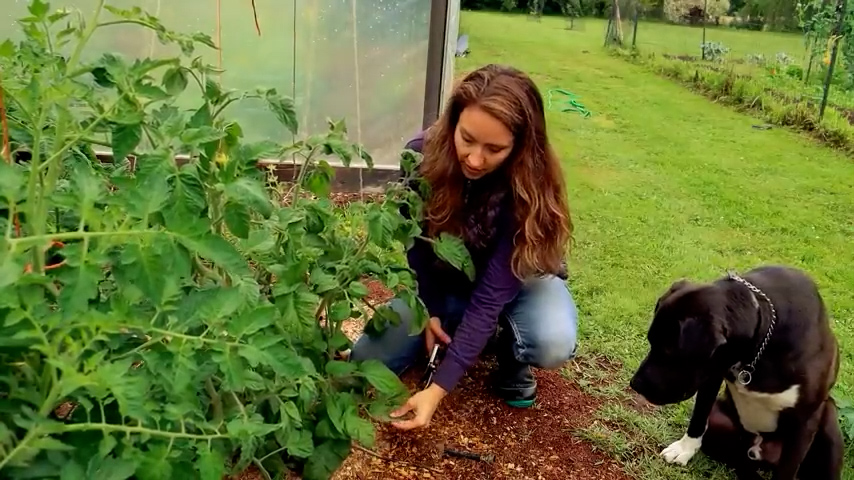
When to Prune Tomatoes
Timing is crucial when it comes to pruning tomato plants. Proper timing provides healthy growth and prevents any harm to the plant. The best time to prune determinate or bush tomatoes is early in the season before they start setting fruit. I get excited when I start to see blossoms and know the fruit is close behind.
Truth be told, I generally don’t prune my determinate varieties and just let them do their thing. If you find you’re dealing with blight or your plants are looking sickly, you may want to consider thinning them out a little.
On the other hand, indeterminate tomato plants should be pruned throughout the growing season to maintain their shape and allow for better airflow. Trellising indeterminate tomatoes is key to maintaining their wild growth. It’s important to understand the specific requirements of your tomato variety and adjust your pruning schedule accordingly for the best fruit size.
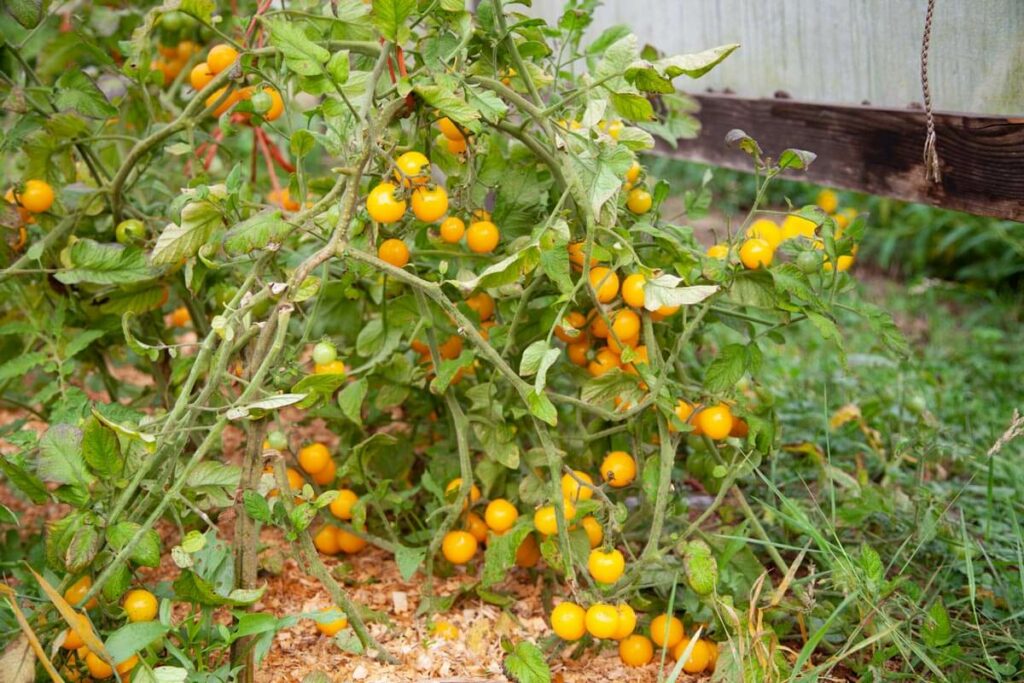
Common Pruning Mistakes
Pruning tomato plants is a delicate task that requires precision and care. Don’t be too hard on yourself if you trim off too much or too little when you’re learning the process; they are pretty resilient.
Here are some common pruning mistakes to look out for to help you navigate the waters when you get to pruning:
- Removing Too Many Leaves – While removing some foliage for better air circulation is good, removing too many leaves can hinder the plant’s ability to photosynthesize and produce energy. Try to balance foliage removal while keeping enough leaves for the plant’s overall health.
- Using Dirty Tools – Always use clean and sharp tools to prevent the spread of diseases.
- Improper Spacing – When planting tomato plants, allow enough space between each plant to improve airflow. Crowded plants can create an environment for diseases to spread, especially determinate varieties that tend to be bushy. Pro Tip: The recommended spacing varies depending on the type of tomato, but generally, allow at least 24-36 inches between each plant.
- Cutting Off Healthy Branches – When pruning, it’s easy to mistakenly remove healthy branches essential for the plant’s growth and productivity. Be cautious when pruning, and make sure you only remove diseased, damaged, or unproductive branches.
- Pruning During the Wrong Time of Day – Pruning tomato plants during the hottest part of the day can cause stress and increase the risk of damage or disease. It’s best to prune early in the morning or evening when temperatures are cooler.
- Confusing Suckers with Productive Branches – Suckers, the small shoots that grow between the main stem and branches of a tomato plant, need to be removed to grow healthier and produce more tomatoes. Try not to confuse suckers with productive branches or flowers. Properly identifying and removing suckers while leaving the productive parts of the plant intact is key to successful pruning. You can keep 3-4 suckers on the bottom part of the plant if it looks like you’re getting good production. Keeping more than that will inhibit the quality growth of the fruit.
- Air Circulation – Adequate air circulation plays an important role in preventing diseases and promoting the growth of healthy tomato plants. Plant tomatoes twenty-four to thirty-six inches apart and prune them according to their variety.
- Trellises or Stakes – Using trellises or stakes for supporting your tomato plants helps keep them upright and enhances air circulation. You can train the branches through pruning to grow upright and keep them from resting on the ground. This way, they will get more sunlight and airflow, a win-win! I use a different form of trellising that works in my high tunnel. See how I trellis tomatoes here.
- Regular Monitoring – Keep an eye on your plants daily. Use good watering practices and look for unwanted pests and diseases. They can come on overnight, my friends, so be on the lookout and act quickly. You want to prevent and treat early blight for tomatoes and other diseases that can spread to other plants.
- Tomato Hornworms – Check the underside of the leaves for signs of eggs. If you notice an extreme loss in your leaves overnight, you may be dealing with tomato hornworms. Find them and pluck them off by using a blacklight in the dark (the hornworms glow and are easy to remove by hand). Pro Tip: Chickens love to eat hornworms!
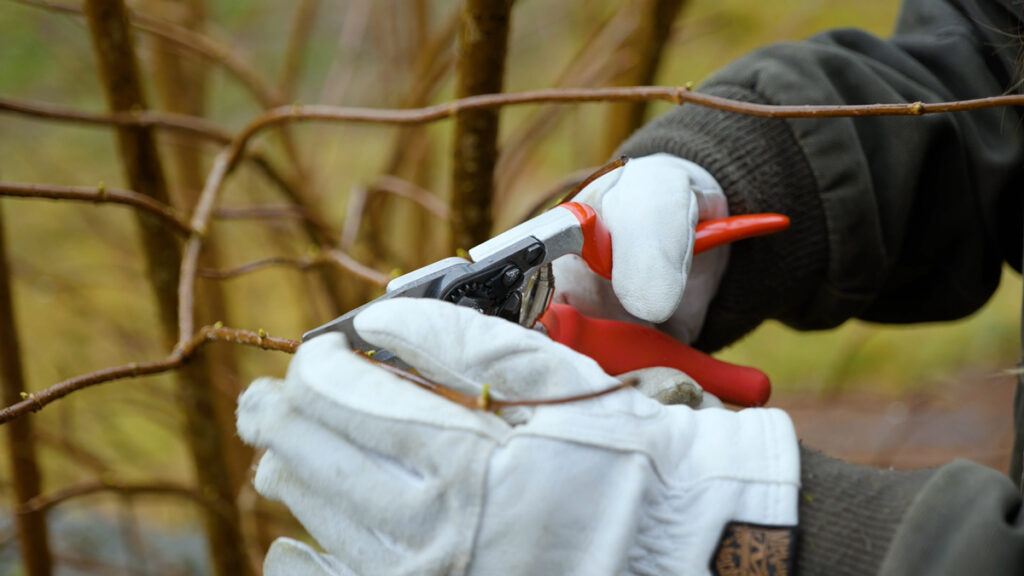
Supplies Needed
It doesn’t require many tools to prune your tomato plants, but these will make a difference in how the plant responds to pruning. Not to mention, you’ll probably find many uses for these tools throughout the year around your homestead and garden.
- Soaker Hoses – Investing in a soaker hose is a worthy investment for your tomato plants. I have found soaker hoses to be the best way to water vegetable gardens. Not only does it increase harvest, but it also eliminates disease. Other watering methods work for different vegetables, but my tomatoes were going to be soaked, not sprinkled or sprayed.
- Pruning Shears – I use my fingers to pinch the small suckers, but for the larger vines, I use pruning shears. If you can’t easily pinch them off, use the shears; you don’t want to leave a gaping wound by ripping it.
- Bucket or Wheelbarrow – The leaves and small branches are easily transported with a bucket or wheelbarrow to the compost pile. These will break down and enrich the soil for the next gardening season. Pro Tip: If your tomatoes are diseased with early or late blight, you do NOT want to compost them. Take them to the trash and get them off your property. You’ll also want to sterilize your pruning sheers before pruning anything else to avoid the spread of fungus.
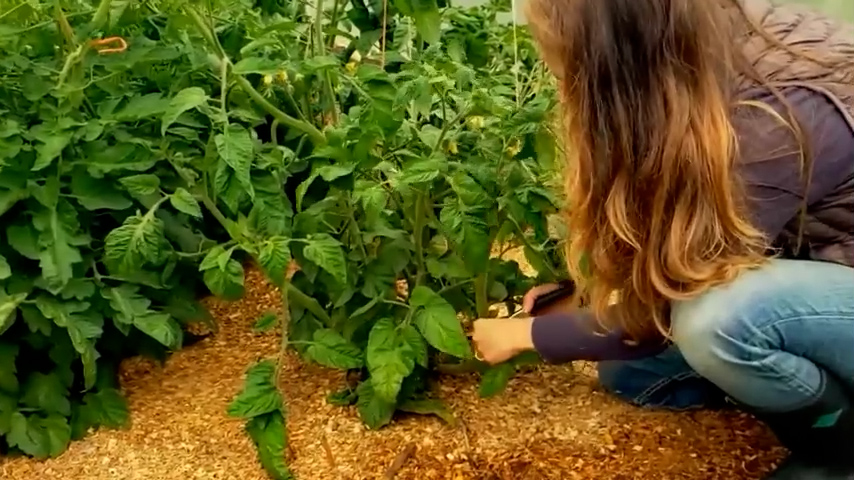
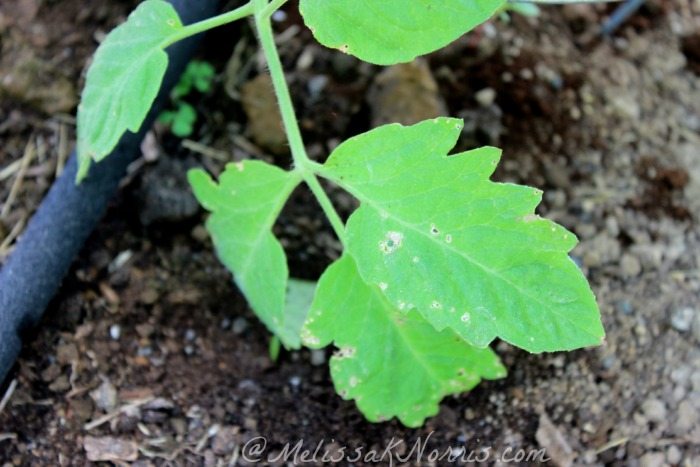
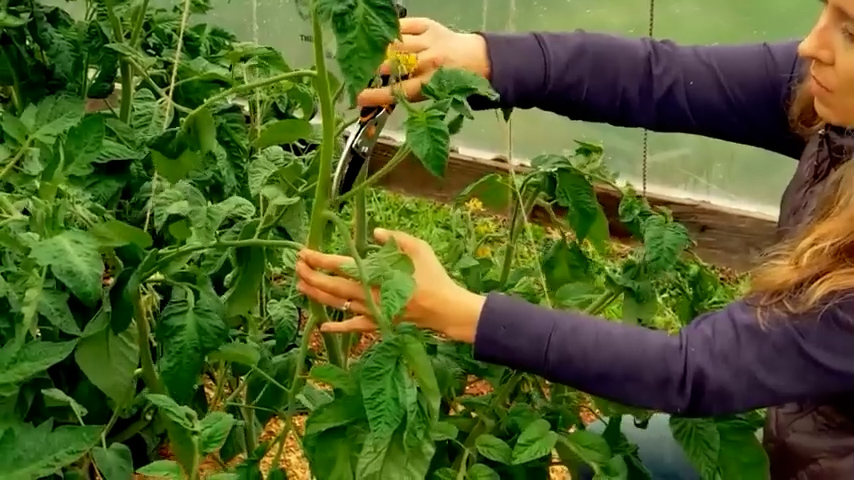
Pruning Tomatoes in Three Easy Steps
- Remove Damaged Branches and Lower Foliage – Start by pruning off all the lower leaves that are touching the soil. Use clean pruning shears (or your fingers) and remove them one by one. This provides better airflow for your tomato plants. Continue to carefully examine your tomato plants for any damaged or diseased branches. These can hinder plant growth and lead to the spread of diseases. Use pruning shears to remove the affected branches, making clean cuts just above a leaf node or where the branch meets the main stem.
- Selectively Remove Suckers – The second part of the plant you’ll want to prune is the sucker shoots. They grow upright and will produce flowers and fruit, but too many of them compete with the main plant and will actually produce a smaller tomato and harvest. This is true for indeterminate tomato plants and heirloom varieties; removing the suckers helps channel the plant’s energy into producing larger fruits. When pruning determinate plants (bushy), it’s best to leave most of the suckers intact, as they contribute to the overall plant growth and larger fruit production.
- Prune for Shape and Size – To make a well-balanced and structured tomato plant, prune for shape and size. Maintaining an open center or pruning the top of the plant at a manageable height is important to promote air circulation, sunshine, and easy access to fruits. Be cautious not to over-prune, which can stress the plant and reduce overall productivity.
Pro-Tip: Don’t leave your pruned leaves on the ground by your tomato plant. Discard them away from the garden so other plants are not susceptible to possible disease.
And that’s it! You now have beautifully pruned tomato plants that should produce a large harvest. If you have any other questions or tips, be sure to leave them in the comments section below!
These tips work best for my cooler/wetter Pacific Northwest conditions, but I think you’ll find that no matter where you live, they will help.
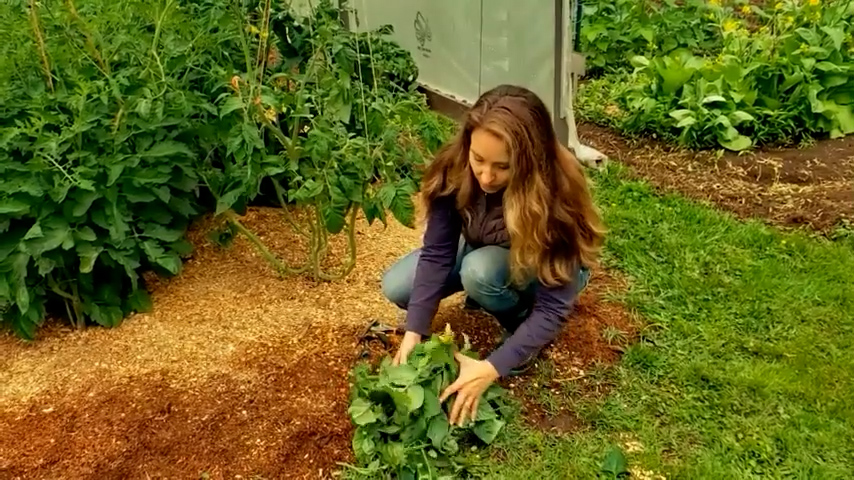
FAQ’s
What is the difference between determinate and indeterminate tomatoes?
Determinate tomatoes are compact and bushy, with a predetermined height and setting fruit all at once. Indeterminate tomatoes continue to grow throughout the season, producing fruit over an extended period.
When is the best time to prune tomato plants?
Determinate tomatoes are best pruned early in the season before they start to set fruit. Indeterminate tomatoes are pruned throughout the growing season to maintain shape and allow for better airflow.
What are some common pruning mistakes to avoid?
Common pruning mistakes include removing too many leaves, cutting off healthy branches, pruning during the wrong time of day, and failing to distinguish between suckers and productive branches or flowers.
How do I prune tomato plants?
To prune tomato plants, start by removing any damaged or diseased branches, then selectively remove suckers and lower foliage to improve air circulation. Finally, prune for shape and size, ensuring a balanced structure.
How do I prune cherry tomato plants?
Pruning cherry tomato plants involves similar principles as other tomato varieties, focusing on maintaining airflow, removing excessive foliage, and encouraging fruiting. Be mindful not to prune too aggressively due to their higher tolerance for foliage.
How do I prune bush tomato plants?
Pruning bush tomato plants, such as determinate varieties, mainly involves maintaining shape and controlling growth. Remove damaged or diseased branches and selectively prune for adequate airflow, being careful not to remove too much foliage to impact fruit development.
What are some pruning tips for optimal results?
For optimal results when pruning tomato plants, use clean and sharp tools, prune when the plants are dry, avoid heavy pruning during hot weather, and adapt the techniques to suit your tomato variety and growing conditions.
How does air circulation contribute to tomato care?
Adequate air circulation is crucial for preventing diseases in tomato plants. Always make sure to use proper spacing between plants, use trellises or stakes for support, and maintain balanced watering, fertilizing, pest control practices, and proper pruning techniques for healthy and thriving tomato plants.
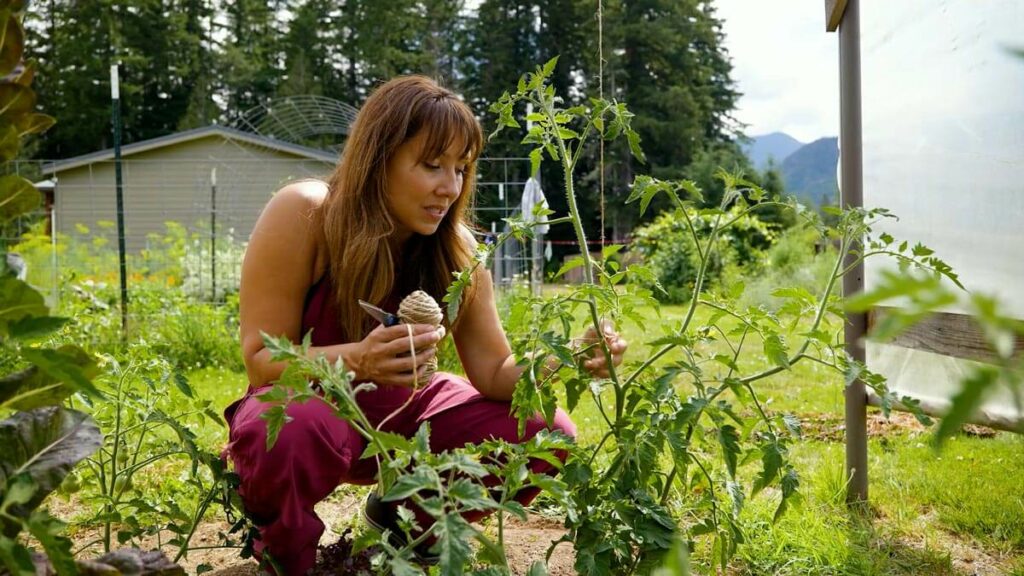
More Tomato-Related Posts
- 10 Tomato Growing Tips for a Disease-Free Harvest
- Storing Green Tomatoes for Fresh Eating
- Preventing & Treating Early Blight of Tomato & Potato Plants
- Trellising Tomatoes the Right Way
- Weston Tomato Press (+ Tomato Sauce Recipe)
- Canned Tomato Sauce Recipe
- Slow Cooker or Instant Pot Cabbage Rolls Recipe
- Homemade Barbecue Sauce Recipe
- 129+ Best Canning Recipes to Put Up This Year
- Canning Problems and Solutions: Siphoning (Liquid Loss in Jars)
- Pressure Canning FAQ’s
Pin this for later!
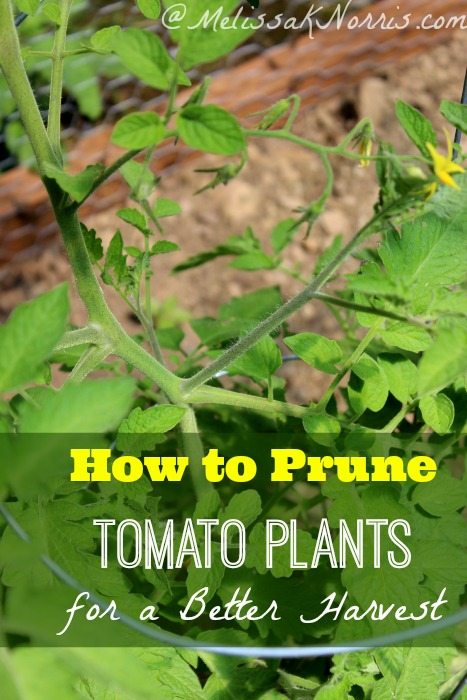
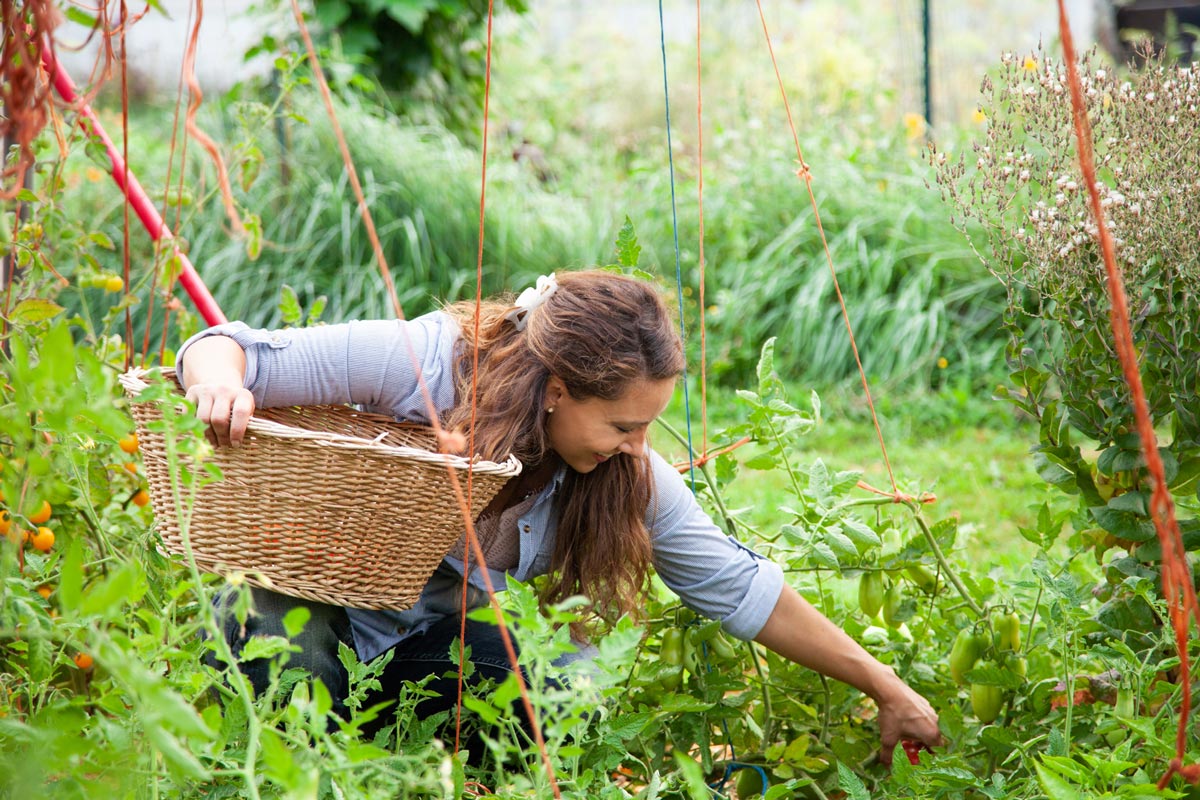
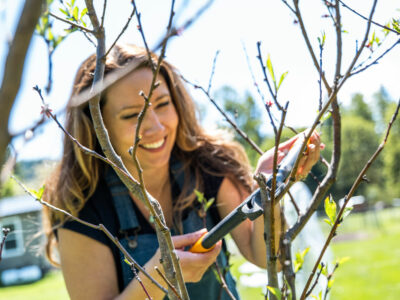
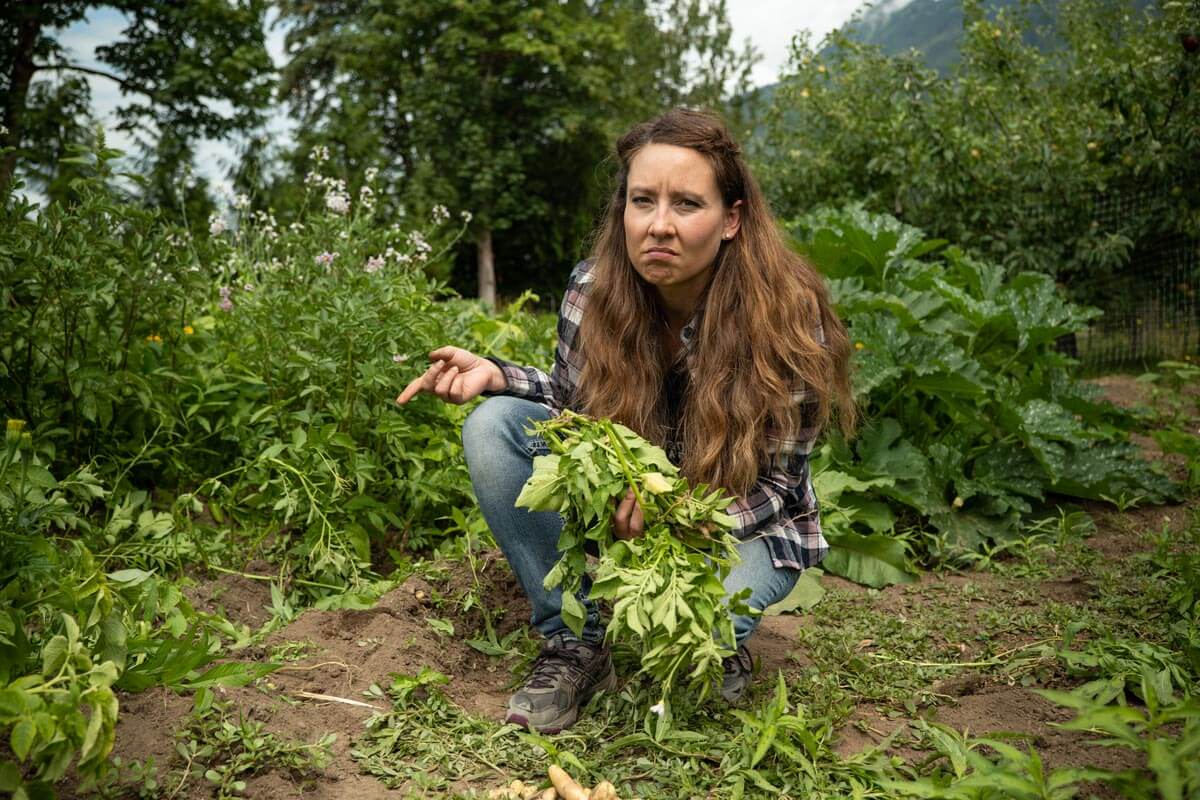
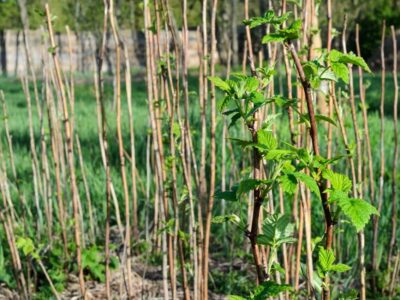
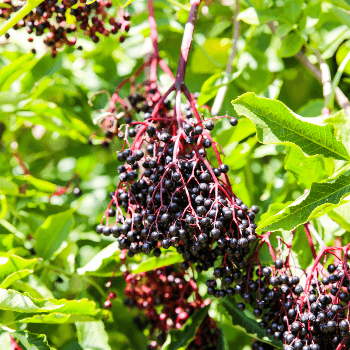
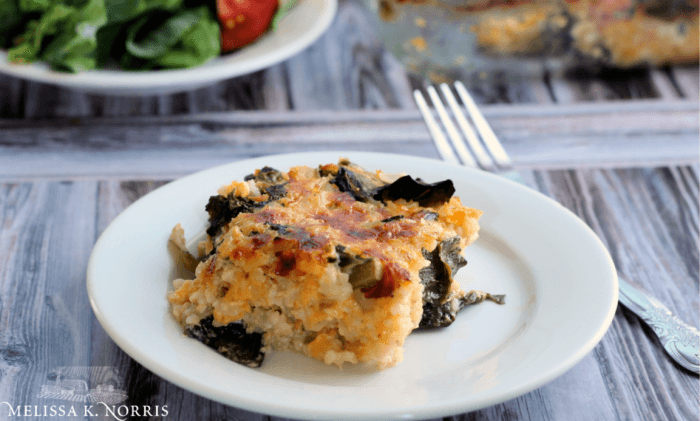
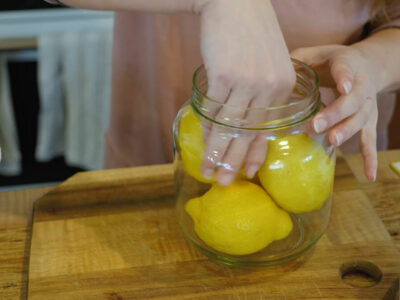
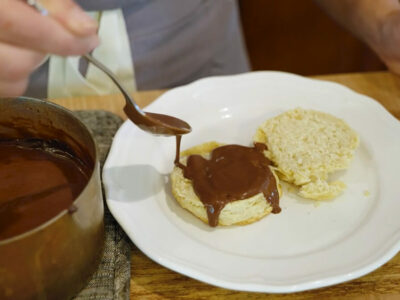
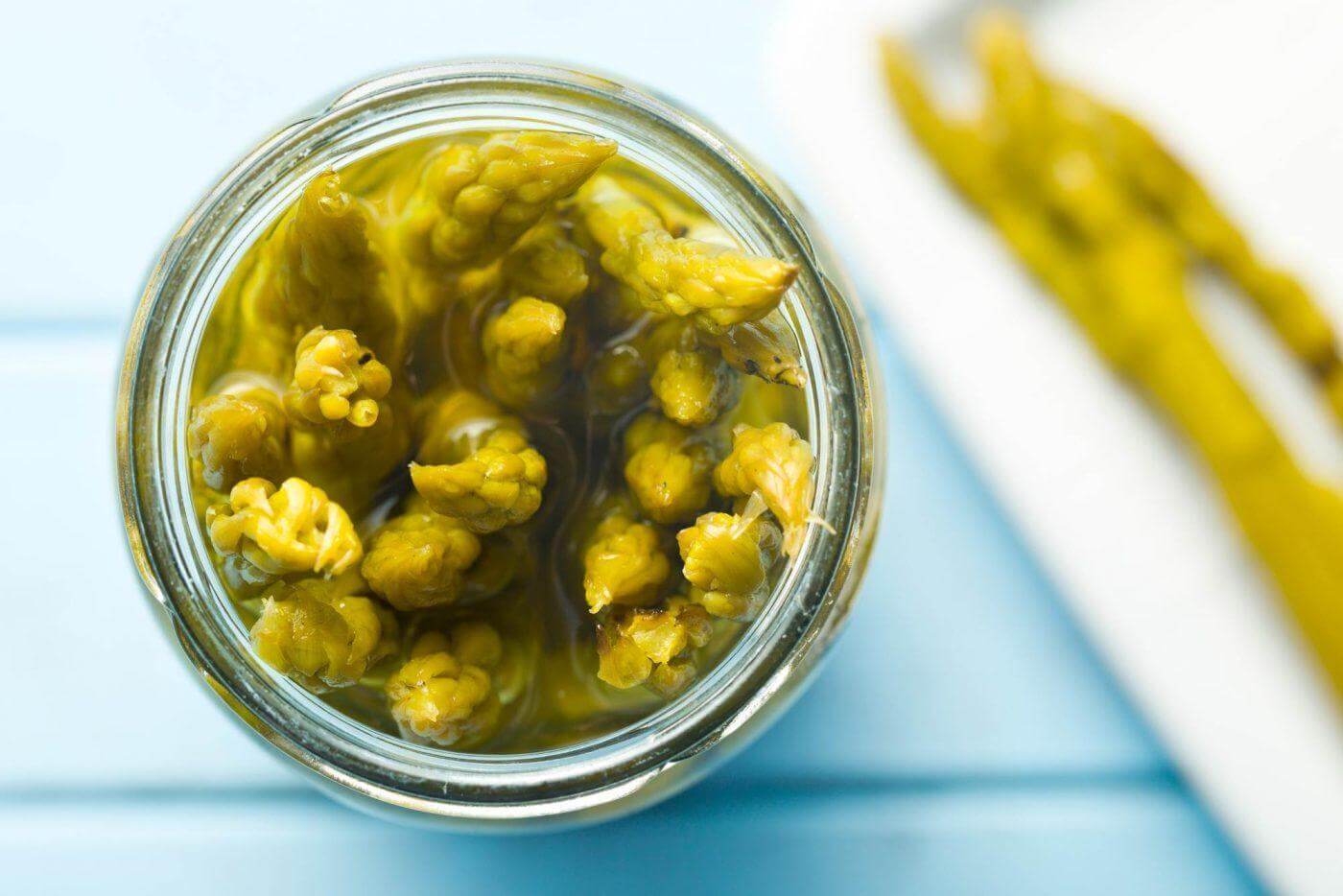

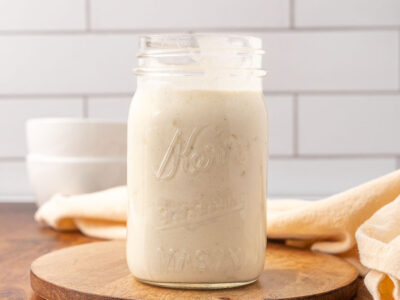
Hi, I am in Battle Ground WA, at the foothills of the Cascades. I have been growing Tomatoes successfully here for 27 years. My question is: Should I be cutting off the flowers that are presenting so early this year? My plants have only been in ground for less than 1 month and they are about 1 foot tall because I bury a good portion when I plant them. I have never seen flowers on my tomatoes when they are this small. I usually cut flowers on other plants when they are small ( tomatillos, bush beans and squash) so the plant puts it energy into grow rather than fruiting. Thanks
I’ve never removed the flowers from annuals, especially with our short growing season.
Great tips
No one has mentioned why we place straw around the tomato plant base!?
i like post on tomato
I think that under How to Prune, first paragraph, last line, you mean indeterminate?
I’m in northern Fla and have been gardening for a few years . Through trial and error on my part I’ve found that I can grow year round in buckets , I use a double bucket system that has a large reservoir of water , for days I don’t have time to water . The yields are pretty good and I have an abundance of fruit , I plant indeterminate tomatoes of 4 different varieties and have been cloning plants for several years , I don’t buy new plants every year , when the plants start to exhibit burn out due to the heat , they’re usually 7 or 8 feet tall , I clip the new shoots and root them in water and then new potting soil and have a new crop of starter plants to grow . Your hints on care for the plants have been very helpful and have increased my plants yield to the point that the wife wants me to cut back on the number of plants next year . We can the excess and have just about used up our available space , on our present schedule we’re putting up about 2 gallons of tomatoes , the ones we don’t eat or pass on to the family , every 2 weeks . Thanks for the help .
Hello, We have 10-11 foot cherry tomatoes plants. If we trim them will they still produce new tomatoes?
Hello from North Carolina! You didn’t mention planting deep, burying the first set of leaves. Also I’ve not seen this anywhere, but my husband lops off the tops of the plants when they get about 3 or 4 ft tall, I really hate to ‘waste’ all the blooms off the top, but it really does a lot to increase the yield. Your thoughts?
Lisa, I do bury deep like you shared but I haven’t cut off the tops. I might have to try it on one or two and do a comparison next year.
An impressive share! I’ve just forwarded this onto a friend who was doing a little homework on this. And he in fact bought me dinner due to the fact that I found it for him… lol. So let me reword this…. Thanks for the meal!! But yeah, thanks for spending time to discuss this subject here on your web site.
lol I hope it was good food!
I had a problem with aphids which moved from cucumbers and zucchini to my artichoke seedlings in the late spring. I treated them with ‘cold garlic tea’ and cleaned as much as I could with duck tape – all with just partial success. Than, one day, after I finished pruning my tomatoes I started watering my garden – artichokes were the first to water and I let the water run over my fingers that got to be deep green from tomato pinching. Dark green water run down my artichokes…The next day I was in total disbelief – there could not be seen a single aphid on them!! So, DO NOT TOSS PINCHED TOMATO SUCKERS – this spring I will crush them and let stand in some cold water for a while, and that water with it plants that show aphids infestation. I have never heard of this before – but just try to remember – have you ever seen aphids on tomatoes? They obviously hate each other!
Amazing! Thanks for sharing 👍🏻
Thank you very much for the tips.I will follow these instructions.
I just read last week an article in the newspaper from a garden specialist that not pruning your tomatoes plants will produce an even better harvest.
Sylvain
Montreal, QC
It depends on if they’re determinate or interdeterminate tomatoes. At the very least your plant will be healthier by removing any diseased or lower branches like I showed. I’ve had larger harvests since I started pruning, which is the proof for anything, what works best for you and your results.
I plant my tomatoes deep, about 1/3 under the ground. A friend of mine whom farms for a living suggested that as it produces much better root structure, thus a stronger main vine. I’ve been doing that for 15
yrs, makes a big difference.
I grow tomatoes. Thank you for that information about calcium and the egg shells
You’re welcome! It’s made a world of difference in ours.
I am brutal when I prune. There’s probably only 10-20% of the non-fruiting foliage left when I am done. I only prune 2-3 time a season, depending on how much growth has taken place. 6 years of pruning with a vengeance and I’ve never had a problem with exposing the fruit to direct sunlight. Some varieties may be susceptible to direct exposure, but mine never have (heirloom paste and roma varieties).
Thanks for sharing Jennifer, I’m going to be a bit more heavy handed in my next pruning as we’re short on water here. And heirloom is the only way to go!!
Thanks. I needed to information, 1st time planting
Melissa
I tried to download this: Free EGuide: How to Preserve Food at Home
112+ Resources to Preserve Food at Home from canning, dehydrating, root cellar and more!
I couldn’t, and was upset. I filled out my email and clicked on Instant Access and it kept going to a page that said Thanks, but bo eBook. Help please!
Patsy,
The link should come to your email. Check your spam folder, but I’ll email you the link right now.
When planting my tomatoes (always indeterminate) , I dig the hole, toss in a palm full of epsom salt , 1/2 cup egg shells and one Caltrate tablet. Water to top of hole and let water drain, ,,, then plant tomato. Never blossom end rot or split tomatoes. Afterwards, I will fertilizer them with a mixture of 1 cup of black strapped, unsulphured molasses added to 1 gallon of milk (powdered is less expensive). Spray early in the morning, Kills bugs, viruses, and snails. Increases the microbiotic action in the soil to produce healthier and MORE tomatoes!
Good Luck
Maria,
Thanks for the tip on the molasses and milk. I hadn’t heard of that one before.
Hi Melissa,
Loved you tomato post! I’ve had problems off and on over the year the tomatoes were perfect! I found a kind I hadn’t tried before. They are called Husky Red. They are determinate but I’ve been picking since July and I still have more to come. The plants are only about 40″ tall and don’t take up nearly as much space as larger plants. The tomatoes are big and very flavorful. No disease, no pruning, drip system evenly watered all season, bushy, green and beautifully healthy. I’,m so excited about these guys I can’t wait to grow them again next year! I blogged about them on my website at http://www.theradishpatch.com under vegetables, if you are interested. So glad I found your site through Pinterest! Donna Jones
I also love Husky Red. I believe they ARE indeterminate, but dwarf. So they will keep producing but never get tall. And the flavor is great
use epson salt in the water that u use to water ur plants 2 tbs in a gal
of water once a week to make the tomatoes bloom and taste better
[…] Tomato Pruning For Better Harvest […]
Melissa, I am wondering what kind of tomatoes those are. They look just like the kind I am growing. The plant was given to me by a friend, who got it from a fellow gardener. By time the plant reached me, my friend no longer remembered the variety of tomato he passed on to me. Any help you can give would be greatly appreciated. (My guess is some sort of paste tomato, but I could be wrong.) Thank you and God bless.
Hi, they’re an heirloom paste tomato (you were totally right!) a San Marzano Number 2 to be exact. They’re said to be the best paste tomato in the world. It’s my first year with them and I can’t wait until they’re ripe.
Thank you, Melissa. Now it’s a matter of being patient until the tomatoes ripen. Have fun in the garden. God bless.
This year we bought a hoop greenhouse and have tomatoes that are reaching the 7′ top. In Colorado, we have freezes through May, so we were able to start early. The tomatoes are loaded and we are anxious to harvest. Does anyone have a really good recipe for chow chow? Thanks for the post. I have never trimmed the vines but will use the info for next year.
I prune out only the first suckers and leave the rest – it gives me a huge harvest. Also, I prune out the downward facing branches starting at the bottom, slowing working my way to the top as the season progresses. Any branches with flowers or young fruit do not get touched. If I feel iffy about taking off a branch, I take off half and that helps as well.
Soil does not need loads of water, but it does need a bit of regular water, perhaps a cupful (literally) once or twice a week. Too much water encourages the unwanted leafy surplus. I also give my plants a weekly feeding of either watered down manure tea or comfrey tea at the roots, never the leaves. Neither smells sweet but it sure gives the plants a good kick in the pants.
Rather than plastic mulch which stops useful minerals, water, worms, etc from helping the soil, I spread about 6 inches of tree bark mulch through the whole garden and that really keeps the weeds in check as well as the soil nicely moist. I’ve never had a problem with slugs or snails.
Cool thing we found about snails or maybe slugs keep forgetting which is which. But if you put big pieces of orange peels out just before dark, it is amazing to see how many of those critters will be clung to it. Don’t remember if you should check it before the over night or next morning. p.s. will be trimming tomatoes tomorrow for sure.
Not sure if anyone mentioned it but, once the tomatoes are approx. 6′ tall, you can also prune/pinch the top of the plant (same as you would for any suckers) to keep it at a manageable height and allow the tomato to put the “tall” energy into fruit energy 🙂
And as an end of season treat, use all the green tomatoes for chow-chow…yum!
Thanks for that tip Ariana! I’m planning on making chow-chow this fall, too.
Never heard of chow chow? Recipe please🙏🏼
How wet is the ground? (Surround the individual plant with black plastic makes life easier! This will hold the water much longer.) Water less often but for a longer time. Stick something (bare-metal) in the ground to see how far down until it shows moist.
Like you we have experienced exactly the same thing trying to grow our tomatoes here in the Pacific NW. Blight, rain, etc. We put ours inside a hoop house this year and and I SO determined to finally get my tomatoes–so far it’s looking good; I just spotted the first blossoms last week. I knew I should be doing some pruning and then came across your post–very timely and helpful. Thanks!
Waah! I was given four beautiful heirloom tomato plants. I have three empty squares and a 2 ft tall stick. I tried pinching back the top; doesn’t seem to have done any good. No worries about leaves touching the ground; the lowest leaf is at least 6 inches up. Everybody else is looking forward to harvest, and I have a stick. ;-( Help!
Feed the plants heavily. If you apply it dry, make sure you mix the food and soil very well. Water them less often but water for a longer time for deeper wetting. NEVER water, spray, feed, or dust them in direct sunlight. Best in the evening so the plant can get the most water and food before the sun dries it out the next day.
Peas do better if you use “the good ole well- decomposed manure. I find the horse manual works the best. Put lots on and mix the soil and manure well. Hoe the dirt/manure onto the plant bottoms to help hold heat (in cold weather) and water. The best thing I ever did was plant everything through black plastic. Till the ground after adding any food/manure, cover the ground with black plastic, place weight (rocks, bricks, pieces of metal, or wood) on the plastic to hold it in place, cut an “x” large enough to plant through, plant and pull the plastic edges from the “x” up to the bottom of the plants (leave the plastic open if you are planting seed), and apply dirt, small stones, etc) to hold the plastic against the roots. Cut slits in the plastic so the rain can drip through. The only thing you have to do is spray with bug, fungi, mold killer and water if it gets very dry under the plastic.
Thanks for this article. I was out in my tomato garden yesterday and debating pruning, but feel guilty clipping off those luscious green stems and leaves. I am not going to feel guilty any more. I also did not realize to clip off the leaves that are touching the ground. What you said makes a lot of sense. Thanks for the tips!
I live in Georgia…so it is hot and can be rainy. I have 5 tomato plants sitting in buckets in my front yard. They are tall and skinny…maybe have about 5 sprouts on them all together. They have been growing since April. I don’t know what to do to get some more sprouts…any ideas?
Lyvonda,
I honestly haven’t had good luck with tomatoes in containers. They like to send their roots deep and unless really large, the containers inhibit this. I’d try transplanting them into something larger or in the ground. Also, I’d give them so extra organic compost or plant food and be sure you’re watering them deeply once or twice week instead of daily. Good luck!
I live on the Texas Gulf coast: hot and humid. I don’t have a “garden” but I grow tomatoes in containers and have been very successful. I buy the biggest plastic containers and cut out the bottom except for about an inch around the inside. I set them anywhere in my back yard where they will get the most sun. I fill them with a mixture of store-bought potting soil and my good compost from my large compost bin (where I also grow worms). I add crushed eggshells also. I have seven containers this year and have gotten a good crop of different heirloom tomatoes. We have to get them set in early because our heat causes them to stop producing by mid to late June. After they are done I fill the pots with heat resistant flowers or simply dump all the dirt into my compost bin and put the pots up. The grass fills in the empty circles where the pots were in no time.
This is my first year with any type of garden. I have 6 tomato plants, one of which is a golden cherry tomato type. So far they are all still alive, which I a big deal for me. 4 of them already have little green tomatoes growing on them. They other 2 have blooms, so I’m still hoping for tomatoes on them. My peas are growing too, but no putting out too many peas. I also have kale, 4 plants, and 2 strawberry plants. I’m hoping that they will all survive. My track record with plants isn’t very good.
Becca,
Peas generally don’t produce as much if it’s really hot out, especially snow peas. Congrats on your garden this year! Each year you’ll learn more and do better and better. I learn something new every year.
I plant my tomatoes up against the south side of my house. This is where they get the most sun and the temps are very hot on summer days. They are protected by most of the rainfall by the roof overhang. We also tie twine around the cages and attach it to the house so our cages don’t tip over as our plants grow huge. We use a soaker hose to water. This time of year, I water twice a day (an hour in the morning and evening) I will be doing my first major trim within the next week. I have a contractor size wheel borrow and have been known to fill it 3/4 of the way full with trimmings from 10-12 plants.
Later in the year (later August) I water less. If I do this, I find my tomatoes are not quiet so watery inside upon harvest. I also feed my tomatoes. I use -used coffee grounds when I plant them, along with crushed egg shell. I throw about a cup ( a nice handful) of grounds in the hole with a couple of crushed egg shells and mix it in with the dirt before adding my plant. I also add coffee grounds on top of the ground throughout the season if it looks like my plants need them. They LOVE coffee grounds.
Toward the end of the season, I trim “at least” 85% of the foliage off my plants. This exposes the tomatoes to the sun for better ripening and gets rid of any chance of blight getting to the foliage and then my tomatoes.
Last year I canned 17+ quarts of homemade Salsa and we ate a lot of raw tomatoes.
If I hear that a hard frost is coming in the fall, I pick all my tomatoes, red, green and in between. I left them on soft towels on a spare table to ripen or I have just left them on my counter to ripen and have had good luck both ways.
Good Luck Growing!
P.S. We had Spaghetti in the crock pot tonight! 3rd day in a row using my crock pot for dinner. A great way to keep the kitchen cool on a hot summer day!
Thanks for your tips! I’ll cut back on watering in August too. And guess what, I’ve got my crockpot out today. 🙂